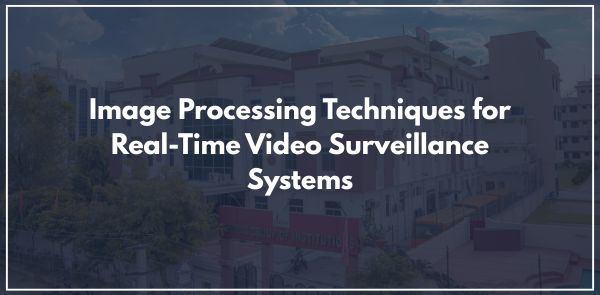Poddar Group of Institutions, a top IT college in Jaipur, is equipping future technologists with cutting edge skills in real-time video surveillance through its industy focused BBA,BCA and MCA programs ,making it the only college in Rajasthan providing hands on experience in their well-equipped Apple labs. Real-time video surveillance systems are indispensable for security, traffic monitoring, and various other applications. However, processing vast amounts of video data in real-time poses significant challenges. Image processing techniques play a crucial role in extracting meaningful information from video streams, enabling efficient and intelligent surveillance.
Challenges in Real-Time Video Surveillance:
Real-time video surveillance systems face several challenges:
- Computational Complexity: Processing high-resolution video streams in real-time requires significant computational resources.
- Dynamic Environments: Surveillance systems must operate effectively in dynamic environments with varying lighting conditions, weather, and object movements.
- Noise and Interference: Video streams are often affected by noise and interference, which can degrade image quality and affect analysis.
- Object Occlusion and Clutter: Objects of interest may be partially occluded or obscured by clutter, making detection and tracking difficult.
- Real-Time Constraints: Surveillance systems must meet strict real-time constraints to ensure timely detection and response to events.
- Storage and Bandwidth Limitations: Storing and transmitting large volumes of video data can strain storage and bandwidth resources.
Image Processing Techniques for Real-Time Surveillance:
Several image processing techniques are employed to address these challenges and enhance the performance of real-time video surveillance systems:
- Background Subtraction: This technique separates foreground objects from the static background, enabling the detection of moving objects. Common methods include Gaussian Mixture Models (GMMs) and frame differencing.
- Motion Detection: Motion detection algorithms identify regions of interest where movement has occurred. Optical flow and frame differencing are commonly used.
- Object Detection: Object detection algorithms identify and localize specific objects of interest, such as people, vehicles, or faces. Deep learning-based methods, such as YOLO and SSD, have achieved state-of-the-art performance.
- Object Tracking: Object tracking algorithms follow the movement of detected objects over time, enabling the analysis of object trajectories and behaviors. Kalman filters and particle filters are commonly used for tracking.
- Feature Extraction: Feature extraction algorithms extract relevant features from images, such as edges, corners, and textures. These features can be used for object recognition and classification. SIFT and SURF are examples of feature extraction algorithms.
- Image Enhancement: Image enhancement techniques improve the visual quality of images, reducing noise and enhancing contrast. Techniques like histogram equalization and Gaussian filtering are used.
- Image Segmentation: Segmentation techniques divide an image into meaningful regions, enabling the analysis of object shapes and sizes. Methods include thresholding, region growing, and clustering.
- Deep Learning for Video Analysis: Deep learning techniques, such as convolutional neural networks (CNNs) and recurrent neural networks (RNNs), are increasingly used for video analysis tasks, including object detection, tracking, and activity recognition.
- Edge Computing: Processing video data at the edge of the network, closer to the camera, can reduce latency and bandwidth requirements.
Implementation Considerations:
Successful implementation of image processing techniques for real-time video surveillance requires careful consideration of several factors:
- Computational Efficiency: Algorithms must be computationally efficient to meet real-time constraints.
- Robustness to Noise and Variations: Algorithms must be robust to noise, varying lighting conditions, and other environmental factors.
- Accuracy and Reliability: Algorithms must provide accurate and reliable results to ensure the effectiveness of the surveillance system.
- Hardware Acceleration: Utilizing hardware acceleration, such as GPUs and FPGAs, can improve the performance of image processing algorithms.
- Scalability: The system must be scalable to handle increasing numbers of cameras and video streams.
- Privacy Considerations: Care must be taken to protect individual privacy when implementing surveillance systems.
Future Directions:
Future research and development efforts in image processing for real-time video surveillance should focus on:
- Developing more efficient and robust algorithms: Improving the performance and accuracy of image processing algorithms.
- Leveraging AI- powered surveillance systems: Integrating AI techniques for advanced video analysis and decision-making.
- Enhancing privacy-preserving techniques: Developing methods for protecting individual privacy in surveillance systems.
- Exploring the use of 3D video analysis: Extending 2D image processing techniques to 3D video analysis.
- Utilizing event-based cameras: Using event cameras that record changes in pixel brightness instead of frames. This reduces bandwith and processing power.
Image processing techniques are essential for enabling efficient and intelligent real-time video surveillance systems. By leveraging these techniques, we can build more effective surveillance systems that enhance security and situational awareness.
